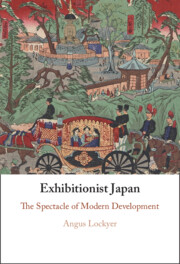Book contents
- Exhibitionist Japan
- Exhibitionist Japan
- Copyright page
- Contents
- Figures
- Acknowledgements
- Note on Names and References
- Introduction
- 1 Early Modern Exhibitions
- 2 Industrial Promotion
- 3 Municipal Branding
- 4 Modern Times
- 5 War and Peace
- 6 Big Event
- 7 Boom Time
- 8 Beyond Development?
- Conclusion
- Select Bibliography
- Index
1 - Early Modern Exhibitions
Published online by Cambridge University Press: 06 February 2025
- Exhibitionist Japan
- Exhibitionist Japan
- Copyright page
- Contents
- Figures
- Acknowledgements
- Note on Names and References
- Introduction
- 1 Early Modern Exhibitions
- 2 Industrial Promotion
- 3 Municipal Branding
- 4 Modern Times
- 5 War and Peace
- 6 Big Event
- 7 Boom Time
- 8 Beyond Development?
- Conclusion
- Select Bibliography
- Index
Summary
Putting things on public display is an ancient habit, which took off in the cities of the early modern world, not least Edo (today’s Tokyo), its largest. It was clear to Japanese observers of international exhibitions in the 1860s, however, that there was a categorical difference between them and the shows of Edo. This chapter uses their experience to specify the difference and to explain why they were able and eager to import the practice of exhibition to Japan. On the one hand, international exhibitions showed Japan to be at odds with the emerging world of industry and empire, not least given its sclerotic political constitution. On the other, by disaggregating its exhibits, they also revealed the archipelago to possess resources (e.g., silk) and abilities (especially craft), with value on the international market. The world of industry and empire, revealed at the exhibition, was a challenging, even threatening, one, but its more perceptive Japanese observers could see reasons for hope.
Keywords
- Type
- Chapter
- Information
- Exhibitionist JapanThe Spectacle of Modern Development, pp. 12 - 37Publisher: Cambridge University PressPrint publication year: 2025

